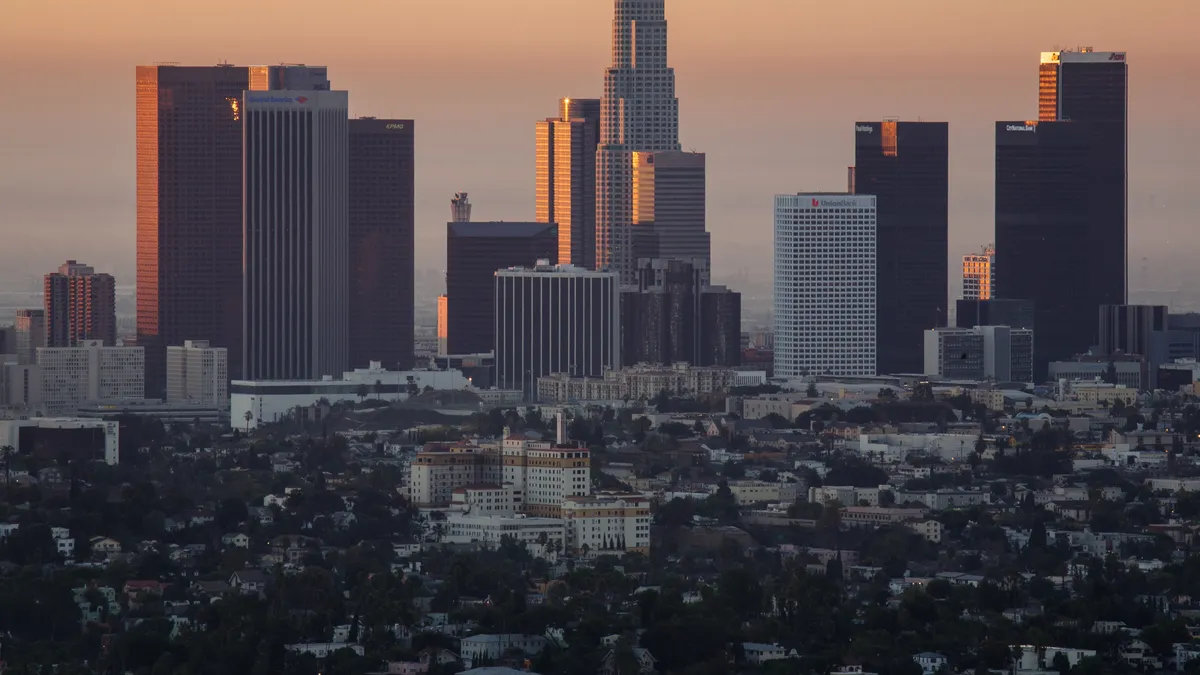Dive Brief:
- Cityzenith, a Chicago-based digital twin platform, announced last week that it is partnering with the Los Angeles branch of the U.S. Department of Energy’s Better Buildings Challenge to help construct a digital twin, or virtual replica, of a section of the city to help make its buildings more sustainable and reduce carbon emissions.
- The project is part of Cityzenith’s “Clean Cities – Clean Future” initiative, which provides cities with a digital twin free of charge, allowing potentially costly decarbonization efforts to be tested virtually before a data-driven decision is made in the real world.
- The endeavor will initially focus on Los Angeles’ downtown neighborhood, Bunker Hill. The partnership will also help Los Angeles work toward its Green New Deal goal to achieve zero net emissions by 2050 across its building sector, which accounts for 43% of the city’s emissions.
Dive Insight:
From Chattanooga, Tennessee, to Las Vegas, an increasing number of cities across the U.S. are turning to digital twin technology.
Chattanooga, for example, has used data from 500 different sources – including 911 data, traffic cameras and weather stations – to feed into the city’s digital twin and ultimately reduce traffic flow by up to 30%.
Cityzenith has also implemented digital twin technology in New York City and Phoenix as part of “Clean Cities – Clean Future.” The company intends to bring digital twins to ten cities through the initiative as its first benchmark, according to Cityzenith CEO Michael Jansen, with potential announcements soon to come in Chicago and Houston.
This technology has “the potential to be a tremendous help to decarbonize existing buildings,” said Aaron Taxy, director of government and public affairs at the Building Owners and Managers Association of Greater Los Angeles. “Through the data it sources and the 360-degree picture it paints, building owners will have the capacity to develop a realistic roadmap to decarbonize in a strategic, cost-effective way.”
The benefits of such decarbonization are two-fold, according to Taxy. “Building decarbonization is often both good for the planet and a wise business decision,” he said. “Decarbonization can lead to major long-term savings on a building’s operating costs if done strategically. And many companies now make building sustainability a priority when leasing new workspace.”
Initially, the Los Angeles project will focus on data related to decarbonization efforts from a major public building and the surrounding area. Data for a project like this typically comes from energy or building management systems, occupancy readings, and architectural information, among other sources, according to Jansen. He added that some of the issues Los Angeles is hoping to address are heating and cooling strategies. The depth of the digital twin will then be expanded to encompass the rest of the city, he said, as well as to address other city planning issues.
“There are no limits to the number of use cases a digital twin will serve,” Jansen said. “There really isn’t anything quite like it out there.”
A trial of the digital twin will be conducted “in the first part of next year,” according to Jansen. He also said that a “baseline digital twin” has already been built with “key assets” and that his team is in the process of gathering the data necessary to complete the project.
The sheer scale of the Los Angeles project also makes it unique, according to Jansen, as does the potential to study microclimates – atmospheric conditions that are different from ones in surrounding areas – in the city’s neighborhoods. It could also lead to work that would decarbonize entire districts as well as individual buildings.
Meanwhile, Bunker Hill was chosen because of its “fascinating history,” according to David Hodgins, executive director of the Los Angeles Better Buildings Challenge, which is funded by the Los Angeles Department of Water and Power. Originally a wealthy area with mansions and luxury hotels, the government deemed it a slum by the mid-20th century. The neighborhood was redeveloped starting in the late 1950s into a commercial business district and cultural center.
A district energy system also sits below Bunker Hill, which Hodgins said creates the potential to increase the number of buildings in Los Angeles that can be decarbonized.










